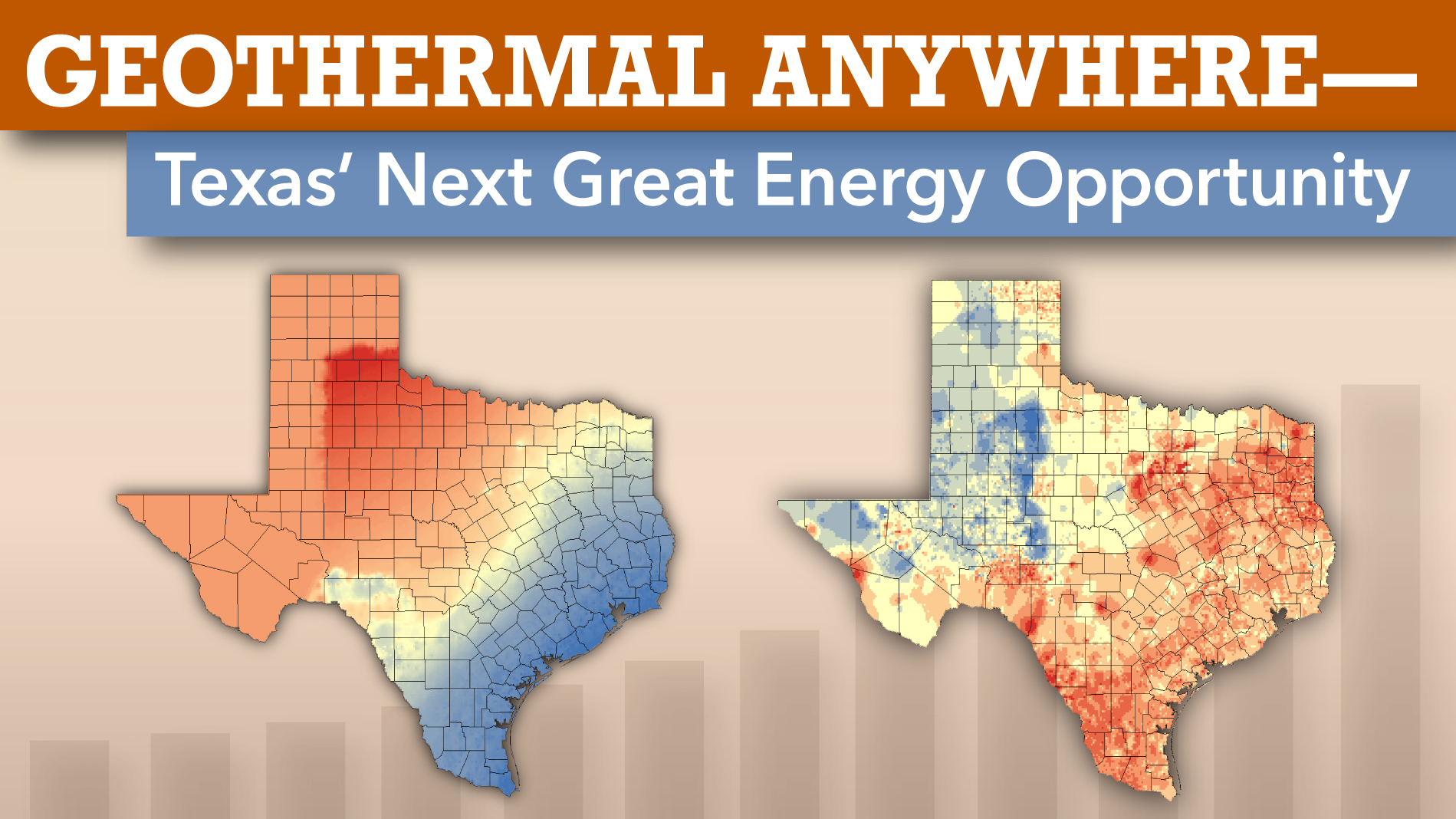Geothermal Anywhere—Texas’ Next Great Energy Opportunity

Texas exhibits great diversity geologically and geographically. Its features range from deep sedimentary basins to basement uplifts, from coastal plains to mountains. The state’s mineral and energy resources are also heterogeneous. Most famously, Texas’ oil and gas development is distinctly zoned in time and space, with areas such as East Texas, coastal Texas, and the Permian Basin having experienced one or more periods of intense exploration and production in the past century.
In the first two decades of the 21st century, a different kind of energy production boomed in Texas—wind. Texas leapt into the national lead in wind power after slightly lagging other states in the early days of the industry. The wind developments also follow relatively distinct geographic zones, which are largely separate from the state’s oil and gas production areas.
Now we look forward to the next energy revolution, one that Texas could lead for the world—geothermal power anywhere. ¹
Texas is not in the United States’ conventional geothermal production zone. In the United States to date, geothermal energy production has occurred (with negligible exceptions) from the Rockies westward. This is because technology has generally only allowed for the exploitation of hydrothermal geothermal systems, wells that tap into natural, dynamic water or steam reservoirs. These systems are tightly tied to tectonics—either volcanism or deep faulting. These settings respectively occur in the Basin and Range province and along the Pacific coast.
The history of geothermal in Texas is relatively brief. A moderate wave of interest and research swept through Texas in the 1970’s and 1980’s. The Bureau of Economic Geology played a major role in the mapping and resource estimation of geothermal in Texas (e.g., Bebout and others, 1978; Woodruff and others, 1982; Ewing and others, 1986). One region that is relatively unique to Texas is the Gulf geopressured zone. This region, where rapid isolation and burial of sediments has resulted in pressures well above hydrostatic and attendant elevated temperatures, has generated interest and study intermittently to the present day and even includes a 1 MW demonstration plant that ran for 6 months and utilized geothermal fluids and coproduced methane for power.
Beyond the history of geothermal science and technology in Texas and worldwide, recent and continuing advances are changing the status quo and opening the door for Texas to add a major new power source to its grid and to develop a major new industry—new-paradigm geothermal. These advances in technology are breaking the old geographic constraint on where geothermal power can be developed and are putting in place a new paradigm: geothermal anywhere. In light of this new paradigm, the Bureau is beginning to re-examine the geothermal potential of Texas. This effort is funded by the Cynthia and George Mitchell Foundation through a grant to the Energy Institute at the University of Texas at Austin.
The major difference between this study and previous work is the inclusion not only of conventional hydrothermal and geopressure, but geothermal anywhere, too. Geothermal anywhere opens up all of Texas, not just select areas, to geothermal power production. Geothermal anywhere will even demand new methods of city planning. When power generation is embedded in a decentralized, organic way at the scale of about 10 MW per plant, policymakers must fold such power infrastructure into growth plans.
Besides the statewide resource assessment, the Bureau is a major part of a Cornell research project on fractures and low-enthalpy geothermal systems. Steve Laubach leads the Bureau’s fracture research group.
Interest is also skyrocketing in an area that could be a major component of geothermal anywhere—the reuse or repurposing of existing (or depleted) oil and gas fields. Texas is a pincushion of hundreds of thousands of wells, and deep oil and gas–producing basins are now coming into viability as geothermal producers thanks to the changing energy economics and the technology advances that are enabling geothermal anywhere. Two key aspects make oil and gas fields attractive: (1) Some fields are relatively deep and reach bottom-hole temperatures of 150°C (~300°F) or higher, generally considered a solidly viable temperature for electricity production given current technology. (2) Infrastructure, particularly wells, is already in place, greatly reducing up-front costs.
The Bureau is also the academic partner for a U.S. Air Force–funded project looking at putting a 3 MW geothermal power plant in at Ellington Field Joint Reserve Base (on the south side of Houston), which is currently in the feasibility-study and design stage. Provided that funding continues, the project expects to break ground within two years.
Other, private geothermal projects are “in the works” in Texas, and readers should watch for announcements as projects receive funding and go public.
References
Bebout, D. G., Gregory, A. R., Loucks, R. G., 1978, Geopressured geothermal fairway evaluation and test-well site location—Frio Formation, Texas Gulf Coast: The University of Texas at Austin, Bureau of Economic Geology, report prepared for U.S. Department of Energy, Division of Geothermal Energy under contract no. AT-E(40-1)-4891(EY-76-S-05-4891), 124 p., https://www.beg.utexas.edu/files/publications/contract-reports/CR1978-Bebout-2.pdf.
Ewing, T. E., Light, M. P. R., Tyler, N., and Morton, R. A., 1986, Consolidation of geologic studies of geopressured geothermal resources in Texas: The University of Texas at Austin, Bureau of Economic Geology, 1984 annual report prepared for U.S. Department of Energy, Division of Geothermal Energy under contract no. DE-AC08-79ET27111, 97 p., https://www.beg.utexas.edu/files/publications/contract-reports/CR1984-Ewing-1.pdf.
Woodruff, C. M., Caran, S. C., Gever, C., Henry, C. D., Macpherson, G. L., and McBride, M. W., 1982, Geothermal resource assessment for the State of Texas—status of progress, November 1980: The University of Texas at Austin, Bureau of Economic Geology, final report prepared for U.S. Department of Energy, Division of Geothermal Energy under contract no. DE-AC97-80ET46617, 127 p., https://www.beg.utexas.edu/files/publications/contract-reports/CR1980-Woodruff-3.pdf.
¹ The geothermal power discussed here is the heat of the Earth specifically used to generate electricity. Geothermal direct use for heating and geothermal heat pumps are not part of this discussion, though they are a significant part of the total geothermal renewable-energy picture.